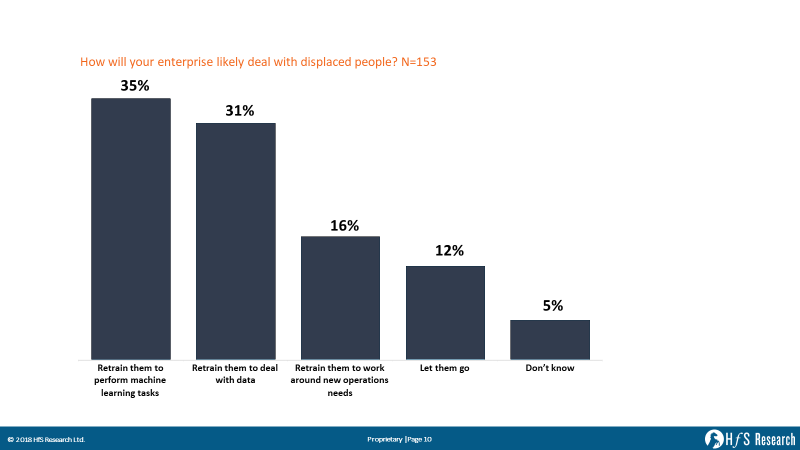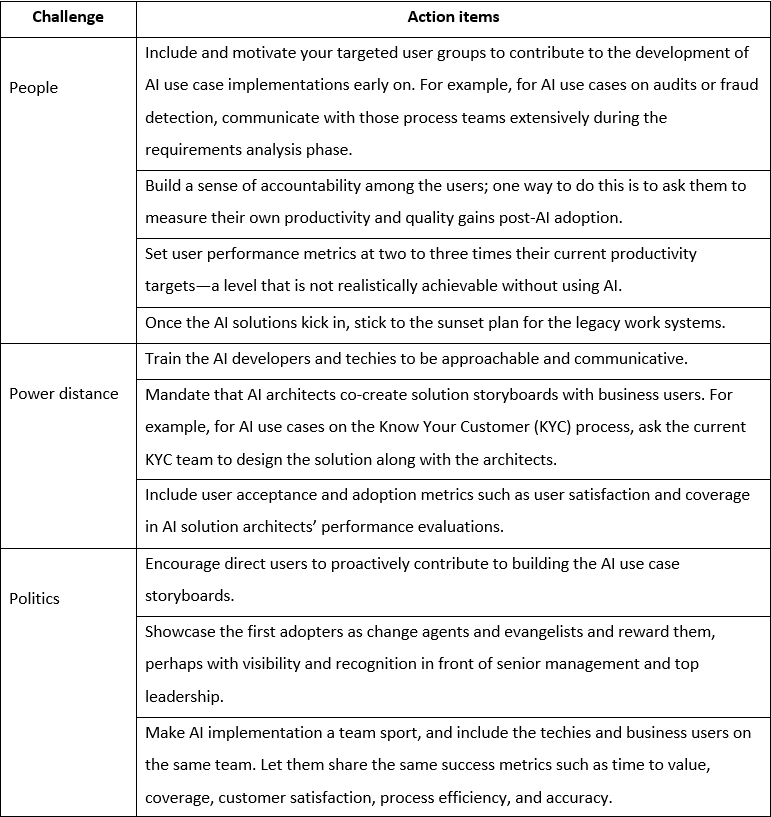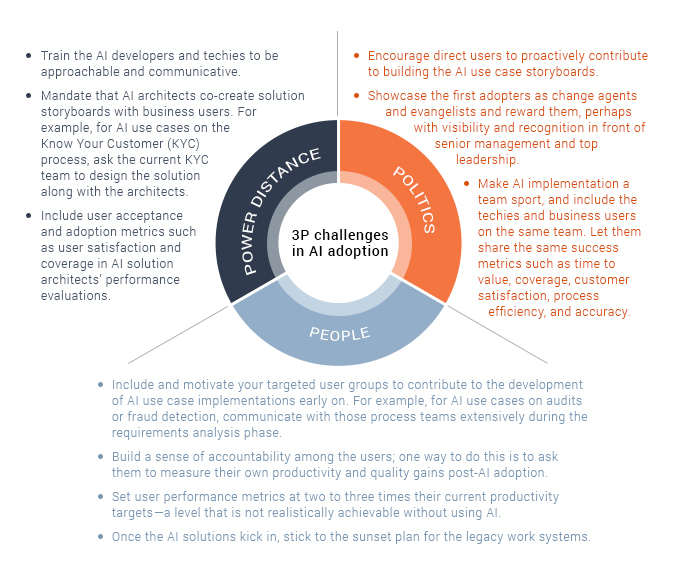The biggest challenges in scaling up AI have nothing to do with the algorithms from innocent math geeks
Two -thirds of respondents to an HFS study on machine learning (ML) adoption indicate that enterprise AI leaders intend to retrain people on basic AI technologies. But, despite all these efforts and investments, scaling up adoption is still a big challenge for many enterprise AI leaders. Technology problems are rather straightforward, understandable, and easier to fix than issues that are softer than software. A line of code can normally be fixed within 24 hours, however, people, power distance, and politics—the 3Ps—are the biggest hindrances to successful AI adoption and scaling.
Here are the 10 actions you can take to combat the 3Ps.
Exhibit 1: People Displaced by Automation

Sample: 153 senior level executives from organizations with $1 billion or more in revenues
Source: HFS Research, 2018
People, power distance, and politics can eat the greatest of AI algorithms for breakfast, lunch, and dinner
Here’s how to tackle the 3Ps.
Include AI adoption plans in your people management practices
Once you have enabled your workforce with sufficient self-paced training resources, certifications, and other training investments, you must communicate—in crystal clear terms—what you expect from these investments and efforts.
- Listen and communicate the targeted user groups for the selected AI use case implementations. When you begin the requirements analysis, include, motivate and communicate extensively and directly with the team members whose current work practices will change.
- Make users accountable for AI usage and ROI. Communicate clearly with the target user groups about their responsibility to adopt the new tools and adapt to working with the AI solutions. You must ensure each individual clearly understands the new demands of them and is onboard the initiative. Those who are not, need to be weeded out, as they could prove highly disruptive down the road.
- Build user performance metrics with steep non-linear productivity and quality of work targets that are not realistically achievable without using the new autonomous AI solutions. Doing so will also showcase to the users how AI use-cases can augment their productivity and quality of work. Challenging staff to lofty goals that stretch them adds to their motivation and team morale, as long as they are guided in the right direction. Really emphasize that AI is about working smarter to achieve targets that were previously deemed impossible.
- Communicate across the teams the sunset plan for the as-is work practices and tools once the AI solutions kick in. The whole point of AI is to eliminate the old ways of doing things. Be strict about the sunset plans for legacy assets and processes. Once user training and pilot programs are complete, execute the new AI-enabled work processes without entertaining any requests for exceptions.
Communication and cooperation bridge the AI power distance between the AI-knowledge haves and the have-nots
Power distance, as defined by social psychologist Geert Hofstede, reflects the degrees of authority between multiple management levels and functions in organizations. AI is deeply complex and is likely to create an internal “digital divide” between the developer geek-gods and the common users who perceive themselves as lesser mortals incapable of performing their AI wizardry. This knowledge inequality inevitably creates a “power distance” between the AI-knowledge haves and the have-nots. Best practices to address this challenge include:
- Train AI developers to communicate the complexities of AI in simple, layman language. For example, use metaphors and real-world examples rather than computer jargon and mathematical formulas, explaining algorithms through visual models and graphics.
- Mandate that AI architects co-create solution storyboards with business users. Train the AI architects to assimilate and analyze the business’s language and build the initial solution storyboards for user personas in their own language, rather than in a codified modeling language like OWL.
- Include user acceptance and adoption metrics in AI solution architects’ performance evaluations. Management should evaluate the technical staff on their efforts to understand both the business contexts in order to build solutions that are viable to be adopted by users.
Evangelizing and gamification can help you tackle politics
Drive a sense of ownership to convert the “tech vs. business” politics into “tech and business” success stories. Promote evangelization, team rewards, team gamification of adoption and productivity, quality enhancements, improved customer satisfaction, and Net Promoter Score [NPS].
- Let direct users contribute to building the AI use case storyboard to foster a sense of ownership. Users will have to feel a solution is “theirs”—that they wanted it, suggested it, helped build it, and finally got it. AI use cases must foster a sense of pride among the intended users.
- Showcase the first adopters as evangelists and reward them. Users and teams, who are proactively taking up available training programs and then using the new AI solutions to augment their performance and productivity, must be given high visibility to senior leadership and promoted as best practice evangelists.
- Make AI implementation a team sport, and include the techies and business users on the same team. Gamify implementation and provide team rewards; for example, reward the IT and business process teams that adopt AI solutions the quickest or the functions that show significant productivity and quality improvements.
Exhibit 2: Monday morning action items for the 3P challenges in AI adoption

The Bottom Line: Act now on the 3P challenge to drive successful AI adoption.
You cannot successfully scale AI adoption by just throwing more technology into the mix, without addressing the issues of people, power, and politics. Here are 10 action items to tackle these 3P challenges and ensure the successful adoption of AI.
